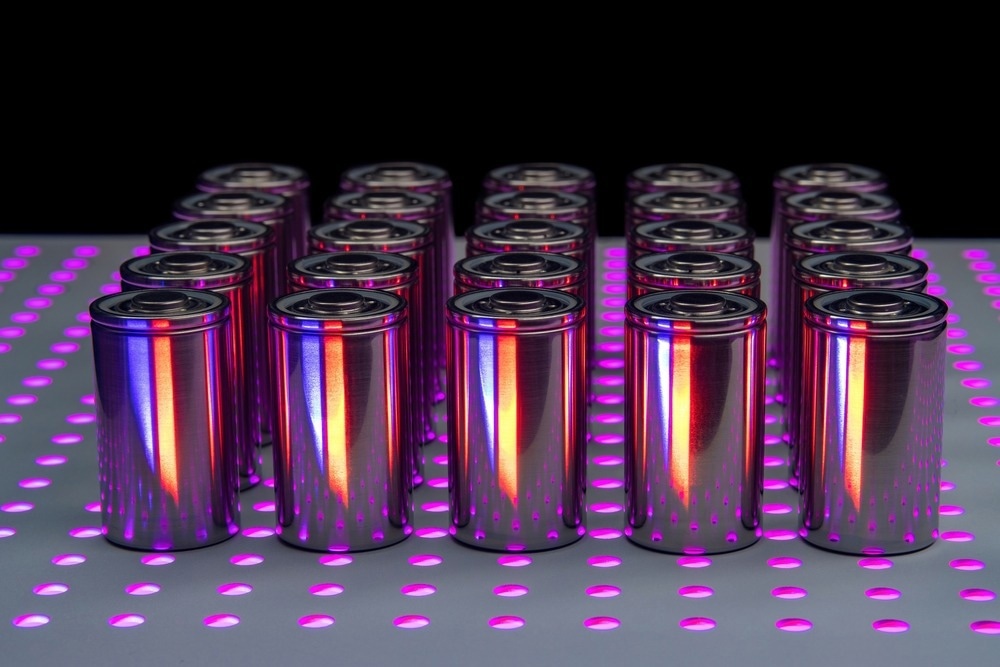The global demand for efficient and sustainable energy storage systems has increased since traditional batteries and supercapacitors face challenges such as limited energy density, reduced cycle life, and safety concerns.

Image Credit: Troggt/Shutterstock.com
In this context, nanomaterials like boron nitride (BN) have opened new avenues for overcoming these obstacles. This article explores the potential applications of boron nitride nanomaterials in revolutionizing energy storage systems.
BN Nanomaterials in Batteries
Boron nitride, when engineered at the nanoscale, exhibits exceptional characteristics that significantly enhance the performance of batteries. BN nanosheets or nanotubes, integrated into electrode structures, offer improved stability. One of the key challenges in traditional batteries is the degradation of electrodes over multiple charge-discharge cycles. BN’s mechanical strength and chemical stability help mitigate this issue, leading to longer-lasting batteries.
Furthermore, using BN increases the energy density of batteries, and its high thermal conductivity facilitates better heat dissipation during charging and discharging processes, reducing the risk of thermal runaway, especially in electric vehicles (Evs), where high energy density and safety are paramount.
BN’s chemically inert nature reduces unwanted side reactions within the battery, enhancing overall efficiency. The compatibility of BN with various electrolytes further expands its applicability, making it a versatile choice for next-generation battery technologies.
BN-enhanced lithium-ion batteries offer a compelling solution in the electric vehicle sector, where range anxiety and charging times are critical concerns. These batteries, leveraging BN's properties, provide higher energy density, longer cycle life, and improved safety. As a result, electric vehicles equipped with BN-enhanced batteries can travel longer distances on a single charge while ensuring the longevity of the energy storage system.
BN in Supercapacitors
BN’s exceptional electrical insulation properties and thermal stability can improve the efficiency and safety of supercapacitors. By preventing leakage currents and reducing internal resistance, BN enhances the charge-discharge efficiency of supercapacitors, making them more reliable for applications requiring quick bursts of power.
The high thermal stability of BN is particularly advantageous in supercapacitors, where rapid energy fluctuations often generate heat. Including BN helps maintain the structural integrity of the supercapacitor, ensuring prolonged performance and safety under demanding conditions.
BN Nanocomposites
The synergy achieved by blending BN with other materials, such as polymers or other nanomaterials, holds immense potential for boosting energy storage capabilities. BN nanocomposites can be tailored to meet specific requirements, combining the strength of BN with the flexibility or conductivity of other materials.
For instance, incorporating BN into polymer matrices can create lightweight and mechanically robust materials ideal for flexible energy storage devices. BN can act as a structural reinforcement in nanocomposite electrodes, preventing mechanical failure and maintaining electrode integrity over numerous charging cycles.
Recent Developments
In a 2019 study, researchers addressed challenges in lithium-ion battery technology by developing high-modulus, ion-conductive gel electrolytes using exfoliated hexagonal boron nitride (hBN) nanoplatelets and imidazolium ionic liquids. The hBN nanoplatelets, produced through scalable liquid-phase exfoliation, enhanced the mechanical modulus of the gel electrolytes by two orders of magnitude without compromising ionic conductivity. This innovation effectively suppressed lithium dendrite growth, providing remarkable performance in rechargeable lithium-ion batteries.
The hBN gel electrolytes exhibited high electrochemical stability, allowing compatibility with high-voltage cathodes, such as lithium nickel manganese oxide. Furthermore, the gel electrolytes demonstrated exceptional thermal stability, enabling high-temperature battery operation up to 175 °C. The study establishes exfoliated hBN ionic liquid gels as a promising solid-state electrolyte for improving the safety and performance of lithium-ion batteries in various applications.
Challenges
Despite the promising outlook, challenges related to the cost-effective and large-scale production of BN nanomaterials for commercial applications persist. The intricate synthesis processes and the demand for high purity raise concerns about scalability. Research efforts are underway to develop cost-efficient production methods and address these challenges.
Conclusion
Boron nitride nanomaterials present a paradigm shift in the landscape of energy storage systems. When harnessed at the nanoscale, their unique properties address critical challenges traditional batteries and supercapacitors face. From improved electrode stability and increased energy density to reduced side reactions and enhanced safety, BN nanomaterials offer a comprehensive solution to propel energy storage technologies into the future.
In conclusion, boron nitride nanomaterials hold immense promise in shaping the future of energy storage. Ongoing research endeavors and collaborations between academia and industry are expected to address existing challenges and drive the integration of BN into mainstream energy storage solutions. The transformative potential of BN nanomaterials positions them as key players in the evolution toward more efficient, safer, and sustainable energy storage systems.
References and Further Reading
Hyun, W. J., De Moraes, A. C., Lim, J. M., Downing, J. R., Park, K. Y., Tan, M. T. Z., & Hersam, M. C. (2019). High-modulus hexagonal boron nitride nanoplatelet gel electrolytes for solid-state rechargeable lithium-ion batteries. ACS nano. http://dx.doi.org/10.1021/acsnano.9b04989
Liu, J., Cao, D., Yao, H., Liu, D., Zhang, X., Zhang, Q., ... & Liu, J. (2022). Hexagonal Boron Nitride-Coated Polyimide Ion Track Etched Separator with Enhanced Thermal Conductivity and High-Temperature Stability for Lithium-Ion Batteries. ACS Applied Energy Materials. https://doi.org/10.1021/acsaem.2c01163
Mateti, S., Sultana, I., Chen, Y., Kota, M., & Rahman, M. M. (2023). Boron Nitride-Based Nanomaterials: Synthesis and Application in Rechargeable Batteries. https://doi.org/10.3390/batteries9070344
Rahman, M. M., Mateti, S., Cai, Q., Sultana, I., Fan, Y., Wang, X., ... & Chen, Y. (2019). High temperature and high rate lithium-ion batteries with boron nitride nanotubes coated polypropylene separators. Energy Storage Materials. https://doi.org/10.1016/j.ensm.2019.03.02
Disclaimer: The views expressed here are those of the author expressed in their private capacity and do not necessarily represent the views of AZoM.com Limited T/A AZoNetwork the owner and operator of this website. This disclaimer forms part of the Terms and conditions of use of this website.